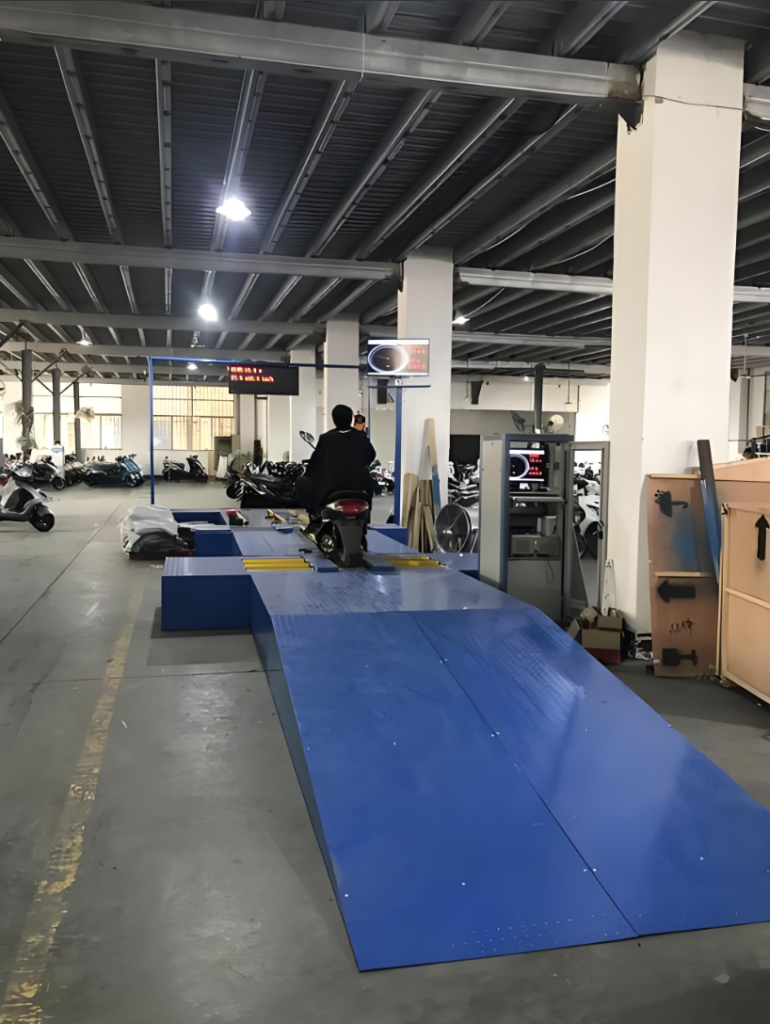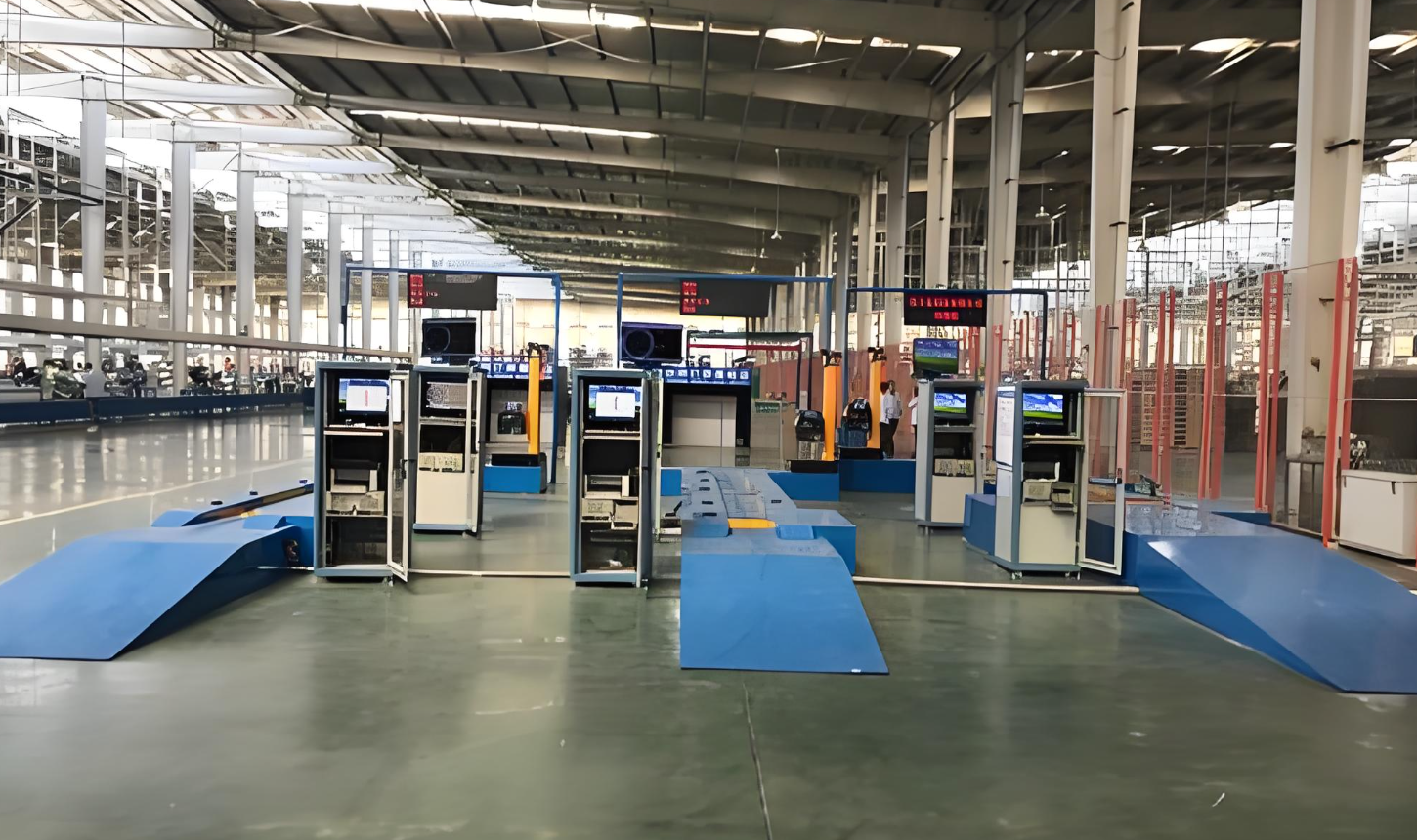Motorcycle testing line Plant

The motorcycle testing line is a specialized piece of equipment designed to assess the safety performance and emissions of motorcycles. It conducts a series of tests to ensure compliance with national safety and environmental standards. These tests typically include axle weight, braking performance, speedometer accuracy, wheel alignment, light intensity, and exhaust emissions. The working principle of the testing line involves using industrial computers and data acquisition control boards, combined with detection and control technologies, multi-screen display technology, multi-threading technology, and network technology, to achieve a streamlined testing process for various motorcycle performance metrics.
The motorcycle testing line usually consists of the following components:
- Wheel Weight Testing Platform: Used to measure the wheel (axle) load and the overall weight of the motorcycle.
- Braking Test Bench: Used to assess the braking performance of the motorcycle.
- Speedometer Testing Platform: Used to verify the accuracy of the motorcycle’s speedometer.
- Wheel Alignment Tester: Used to check the co-planarity deviation of the front and rear wheels of two-wheeled and tricycle motorcycles.
- Headlight Tester: Used to measure the luminous intensity of the motorcycle’s headlights.
- Exhaust Gas Analyzer: Used to check whether the motorcycle’s exhaust emissions meet standards.
The testing line is typically divided into multiple stations, each responsible for different testing tasks. For example, station one may test acceleration performance and maximum speed, station two may verify the speedometer, station three may assess the braking force and axle weight, station four may check the co-planarity of the wheels and the horn sound level, station five may test the headlights, and station six may conduct exhaust emissions testing.
The level of automation in the testing line is relatively high, which helps reduce the probability of human error and improves testing efficiency and accuracy. Testing data can be stored in real-time, transmitted back, and uploaded to higher-level regulatory platforms. The control system of the testing line is typically managed by a computer, which automatically controls the testing equipment, displays the testing process, and guides the operator through various tasks. The testing results are printed out and can be archived in the system.
In terms of technical parameters, different testing lines may vary, but they generally comply with relevant national standards, such as JJG906, JJG909, JJG1014, etc. For example, the wheel weight testing platform may have a measurement range of 0-500 kg, the braking test bench may measure braking force up to 1500 N, the headlight tester may have a range of 0-120,000 cd, and the exhaust gas analyzer may measure CO: 0-10% and HC: 0-10,000 ppm, etc.
Overall, the motorcycle testing line is an efficient and automated testing system that ensures motorcycles meet safety and environmental requirements before leaving the factory or during their use.

Motorcycle testing lines vary in standard test items from country to country, reflecting different requirements for motorcycle safety and emissions. Here are some possible differences:
- Emission Standards: Different countries have varying regulations on emission limits for motorcycles. For example, the European Union has strict emission standards such as Euro 5, while the United States has its own standards like EPA regulations. China is continuously improving its motorcycle emission standards, such as the “Motorcycle Pollutant Emission Limits and Measurement Methods (China Stage 4)” (GB 14622-2016) and “Lightweight Motorcycle Pollutant Emission Limits and Measurement Methods (China Stage 4)” (GB 18176-2016).
- Safety Performance: Safety performance requirements for motorcycles also differ among countries. Some countries may require motorcycles to be equipped with ABS (Anti-lock Braking System), while others may not have such requirements. China’s national standards catalog includes multiple safety standards related to motorcycles, such as GB 811-2010 “Motorcycle Rider’s Helmet.”
- Lighting and Signaling Equipment: Testing requirements for lighting and signaling equipment on motorcycles can vary from country to country. Some countries may require specific daytime running lights or turn signals.
- Braking Performance: Braking performance is an important part of motorcycle safety testing, and different countries may have different performance requirements and testing methods for braking systems.
- Noise Levels: Some countries have strict limitations on noise levels for motorcycles, which usually need to be determined through specific tests.
- Durability and Reliability: Durability and reliability testing for motorcycles may have different standards and test cycles in different countries.
- Tires and Rims: Different countries have different requirements for the performance of motorcycle tires and the specifications of rims.
- Electrical Systems: The electrical systems of motorcycles, including batteries, cables, and lighting, may need to meet specific national safety standards.
It should be noted that motorcycle manufacturers often need to adjust to the regulatory requirements of different markets to ensure that their products can be sold locally. Additionally, with the development of globalization, some standards are becoming international, such as ECE (Economic Commission for Europe) and ISO (International Organization for Standardization) standards, which are adopted by multiple countries.
